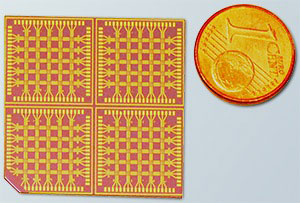| Nov 24, 2010 |
Bio-detection: Building bridges with DNA
|
|
(Nanowerk News) Electrical sensor arrays are useful tools for rapid and early diagnosis of cancer and other genetic diseases. Zhiqiang Gao and co-workers at the A*STAR Institute of Bioengineering and Nanotechnology have developed an array that can sense messenger RNA (mRNA) for quantitative gene expression profiling ("Electrical Sensor Array for Polymerase Chain Reaction-Free Messenger RNA Expression Profiling").
|
 |
| Fig. 1: Photograph of the prototype electronic sensor array for ultra-sensitive and specific mRNA detection.
|
|
Conventional gene expression profiling methods rely on the amplification of target DNA through polymerase chain reaction (PCR) technologies and the detection of fluorescent labels. However, these methods are expensive to run and have low throughput. The researchers designed a high-sensitivity PCR-free device that directly quantifies gene expression using a two-step hybridization of the target mRNA. "Our goal is to develop a highly portable molecular diagnostic system," says Gao, who led the research group.
|
|
At the heart of this device is a pair of vertically aligned gold microelectrodes, separated by an insulating 'nanogap' and deposited onto a silicon chip using standard photolithography. After anchoring polythymine probes complementary to the mRNA polyadenine tails on the top microelectrodes, they attached target-specific 'capture probes' on the bottom microelectrodes. Hybridization of the target mRNA extremities with the immobilized probes bridged the nanogap. Finally, the team coated the resulting mRNA–DNA complex with silver to generate a conducting wire between the electrodes for signal detection.
|
|
The researchers then designed an array with capture probes specific to an mRNA called GAPDH. They found that the device selectively bound to target strands present in total RNA, which also contains other RNA molecules, even at extremely low concentrations. The strength of the detected signal increased in proportion to the GAPDH concentration. The researchers also observed a current when they covered the top electrodes with GAPDH-specific capture probes, indicating that a few target strands, which are longer than the nanogap, could reach the opposite electrode.
|
|
The sensitivity and detection limit of the array increased with the length of the genes and surpassed the performance of the best direct mRNA expression profiling methods. The team also demonstrated that the device readily distinguished mismatched mRNA sequences—proof of its specificity—and achieved the same level of performance as quantitative PCR methods for the analysis of real-life samples, particularly for normal and breast cancer tissues.
|
|
"The vertical nanogap structure and two-step–two-probe hybridization eliminate much of the background noise," says Gao. "The metallization of DNA generates an excellent signal."
|
|
The ultrahigh signal-to-noise ratio and minimal sample preparation requirements enhance the potential adaptability of this array to miniaturized analytical platforms. The team is currently optimizing the sensor and developing new prototypes for commercialization.
|

